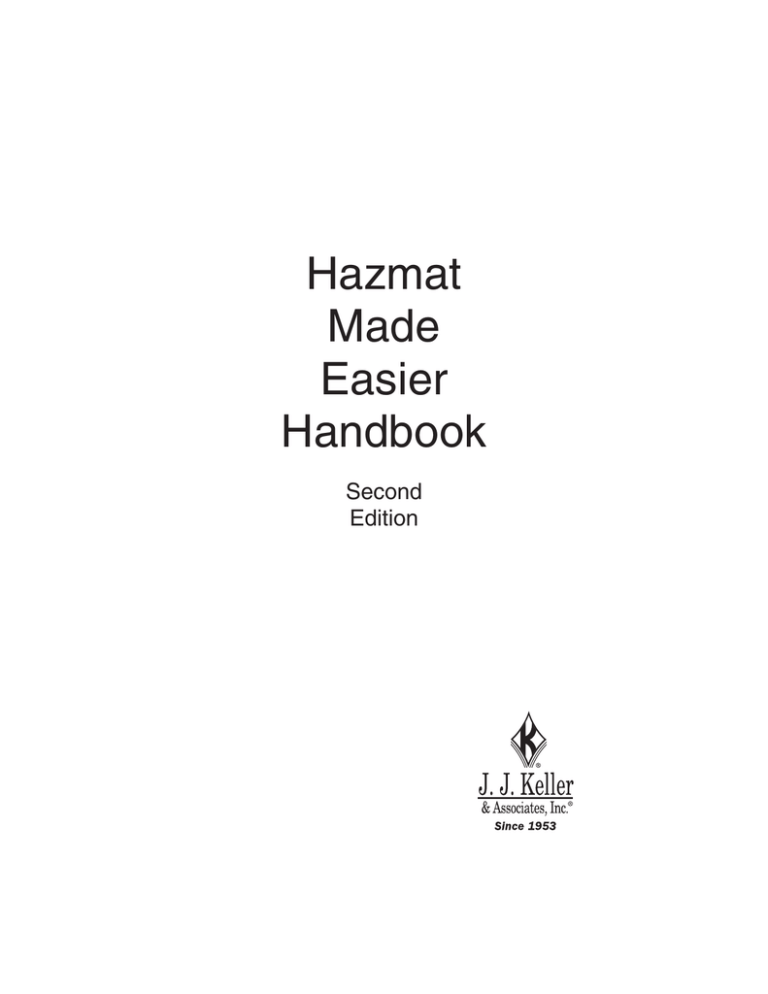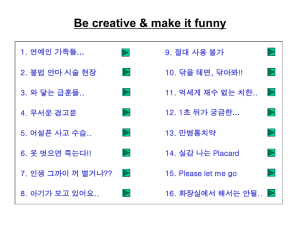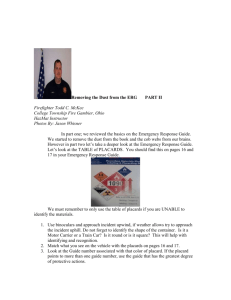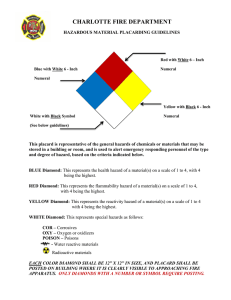
Hazmat
Made
Easier
Handbook
Second
Edition
©2008 J. J. Keller & Associates, Inc.®
Neenah, WI 54957 Printed in USA
J. J. Keller & Associates, Inc.®
3003 W. Breezewood Lane, P.O. Box 368
Neenah Wisconsin 54957-0368
Phone: (800) 327-6868
Fax: (800) 727-7516
jjkeller.com
LCCN: R123-317687
ISBN: 978-1-60287-607-1
GST No.: R123-317687
Second Edition, Tenth Printing, August 2011
All rights reserved. Neither the publication nor any part
thereof may be reproduced in any manner without written
permission of the Publisher. United States laws and
Federal regulations published as promulgated are in public
domain. However, their compilation and arrangement along
with other materials in this publication are subject to the
copyright notice.
Due to the constantly changing nature of government
regulations, it is impossible to guarantee absolute accuracy
of the material contained herein. The Publisher and Editors,
therefore, cannot assume any responsibility for omissions,
errors, misprinting, or ambiguity contained within this
publication and shall not be held liable in any degree for
any loss or injury caused by such omission, error,
misprinting or ambiguity presented in this publication.
This publication is designed to provide reasonably accurate
and authoritative information in regard to the subject matter
covered. It is sold with the understanding that the Publisher
is not engaged in rendering legal, accounting, or other
professional service. If legal advice or other expert
assistance is required, the services of a competent
professional person should be sought.
The Editorial Staff is available to provide information
generally associated with this publication to a normal and
reasonable extent, and at the option of and as a courtesy of
the Publisher.
Report Content Piracy
800-388-7478
www.siia.net/piracy
Hazmat Made Easier
Handbook
Table of Contents
Labeling............................................................................................. 35
Placarding.......................................................................................... 41
Labeling
(Part 172, Subpart E)
Hazard warning labels are meant to
communicate immediate warning of a
hazmat’s
hazards.
The colors and symbols on the various labels are designed to
provide easy recognition of the hazard(s) a
hazmat presents in
transportation. Labeling requirements are
targeted almost exclusively at non-bulk packaging. The responsibility for the labeling
process belongs to the person offering the hazmat for transportation. However, the carrier also is responsible. The carrier must
make sure that packages containing hazmat have been properly labeled according to the requirements before accepting and
transporting them.
Label specifications (172.407)
Labels must be durable, weather resistant, and able to withstand, without deterioration or substantial change in color, a
30-day exposure to transport conditions.
Each diamond-shaped label must be at least 100 mm (3.9
inches) on each side, with each side also having a solid line
inner border 5.0 to 6.3 mm (0.2 to 0.25 inch) from the edge of
the label.
The hazard class/division number must be at least 6.3 mm (0.25
inch) and not greater than 12.7 mm (0.5 inch). If text indicating
a hazard is displayed, the text must be shown in letters measuring at least 7.6 mm (0.3 inch) in height. The words “Spontaneously” and “When Wet” must be at least 5.1 mm (0.2 inch)
in height, respectively, for SPONTANEOUSLY COMBUSTIBLE
or DANGEROUS WHEN WET labels.
35
Labeling
The background color for the various labels must be as prescribed in 172.411 through 172.448, and the printing, inner border and symbol on each label must be as shown.
In most cases, the symbol, test, numbers, and border must be
black. However, white may be used on a label with a one color
background of green, red, or blue. White must be used for the
text and class number for the CORROSIVE label.
Primary and subsidiary labels (172.402)
There are two types of hazard warning labels. A primary hazard
label indicates a hazmat’s most hazardous property; a subsidiary hazard label indicates other less hazardous properties.
Subsidiary labels have numbers in the lower corner, just like
primary labels.
You may see subsidiary labels that have no number in the lower
corner. Subsidiary labels without a number in the lower corner
could not be used in domestic transportation starting October 1,
2005.
When primary and subsidiary hazard labels are required together, they must be displayed next to each other (within 6
inches).
Determining labels (172.101 & 172.400)
The Hazardous Materials Table is used for determining appropriate hazard warning labels.
First, locate the proper shipping name in Column 2 of the Table.
Then, refer to Column 6 for the appropriate label code(s).
The first label code indicates the hazmat’s primary hazard. Any
additional label codes listed are subsidiary hazards. Usually the
label code is the same as the hazard class or division for the
label. You can also use the Label Substitution Table in
172.101(g). There is another table located in 172.400, that
should be used in determining additional subsidiary labels.
For the 6.1 label code, there are two possible labels. Hazmat
that has a Hazard Zone A or B requires a POISON INHALATION
HAZARD label; any other 6.1 hazmat will require a POISON
label.
36
Labeling
Exceptions (172.400a)
As mentioned earlier, not all non-bulk packages of hazmat need
to be labeled. Labels are not required on:
• A cylinder or Dewar flask (173.320) containing a Division
2.1, 2.2, or 2.3 material; that is not overpacked; and that is
durably and legibly marked in accordance with CGA Pamphlet C-7, Appendix A.
• A package or unit of military explosives, including ammunition, shipped by or on behalf of the U.S. Department of
Defense (DOD) when in freight container-load, car-load, or
truck-load shipments, if loaded and unloaded by the shipper or DOD, or in unitized or palletized break-bulk shipments by cargo vessel under charter to DOD, if at least one
required label is displayed on each unitized or palletized
load.
• A package of hazmat, other than ammunition, that is
loaded and unloaded under the supervision of DOD personnel and is escorted by DOD personnel in a separate
vehicle.
• A compressed gas cylinder that is permanently mounted in
or on a transport vehicle.
• A freight container, aircraft unit load device, or portable
tank that is placarded in accordance with or identified as
provided in the International Civil Aviation Organization
(ICAO) Technical Instructions.
• An overpack or unit load device in or on which labels that
represent the hazard(s) inside are visible.
• A package of low specific-activity radioactive material
when being transported in a conveyance assigned for the
exclusive use of the consignor under 173.427(a)(6).
• A package containing a PIH material in a closed transport
vehicle or freight container may be excepted from labeling
or placarding under certain conditions in 49 CFR 171.23.
• Not withstanding the provisions of 49 CFR 172.402(a), a
Division 6.1 subsidiary label is not required on a package
37
Labeling
containing a Class 8 (corrosive) material that has a subsidiary hazard of Division 6.1 (poisonous) if the toxicity of
the material is based solely on the corrosive destruction of
tissue rather than systemic poisoning. In addition, a Division 4.1 subsidiary hazard label is not required on a package bearing a Division 4.2 label.
Certain exceptions for labeling requirements are also provided
for small quantities and limited quantities in 49 CFR Part 173.
Label placement (172.406)
A label must be printed or affixed to the outside surface of a
package containing hazmat, but not on the bottom. Labels
should not be hidden or concealed; they must be easily seen.
Labels must be on a background of contrasting color or have a
dotted or solid line outer border. You must also put the label on
the same side and near the proper shipping name, when possible.
Duplicate labeling is not usually required on a package, only one
of each required label is necessary. However, duplicate labeling
may be required for larger packages and radioactive packages.
See 172.406(e).
What if the package is very small? A label may be printed on or
put on a securely affixed tag or affixed by other suitable means
to:
• a package that is smaller than the required label if it is not
a radioactive hazmat;
• a cylinder; and
• a package that has an irregular surface.
Mixed and consolidated packaging (172.404)
Hazmat with different hazard classes packed in the same packaging, or within the same outside container or overpack, must
be labeled for each of the different hazard classes.
Also, an outside container or overpack must be labeled as required for each class of hazmat when two or more packages
with compatible hazardous materials are put in the outside container or overpack.
38
Labeling
Label modifications (172.405)
Text indicating a hazard is not required on Class 1, 2, 3, 4, 5, 6,
and 8 primary or subsidiary labels.
The OXIDIZER label may be modified to display the word “OXYGEN” and the class number “2,” which can then be used instead
of the NON-FLAMMABLE GAS and OXIDIZER labels for packages with the proper shipping names “Oxygen, compressed” or
“Oxygen, refrigerated liquid.” The word “OXYGEN” must appear
on the label.
The POISON label may be modified to display the text “PG III”
below the midline of the label for packages containing a Division
6.1, Packing Group III hazmat.
6
39
Labeling
ORGANIC PEROXIDE label (172.427)
HM-215I revised the ORGANIC PEROXIDE label. The new
label reflects the fact that organic peroxides are highly flammable and enables transport workers to readily distinguish peroxides from oxidizers.
Except for size and color, the ORGANIC PEROXIDE label must
be as follows:
The background on the label must be red in the top half and
yellow in the lower half. White may also be used for the symbol
for the ORGANIC PEROXIDE label.
40
Placarding
(Part 172, Subpart F)
Placards are often confused with labels, simply because they look
so much alike. Placards are much larger
and are usually placed
on much larger packages.
The purpose of placards is very similar to
the purpose of labels.
Placards communicate
the hazards associated
with various materials
in transportation, and
also provide emergency personnel with the information they need when incidents
occur — two good reasons why it is important to make sure you
select and display the right placards.
Placarding requirements (172.504)
Each bulk packaging, freight container, unit load device, transport vehicle, or rail car containing hazmat must be placarded,
with some exceptions.
To determine the placards required, you must know:
• Whether the packaging is bulk or non-bulk.
• The hazard category (class, division, packing group, or
description), and subsidiary hazard(s), if any.
• The weight of non-bulk packages in each hazard category.
41
Placarding
Table 1 (172.504)
The most dangerous hazmat categories are located in Table 1.
Any quantity of hazmat in the categories listed in Table 1 must
be placarded.
Table 1
Placard name
Category of material
(Hazard class or
division number and
additional description,
as appropriate)
Placard design
section reference (§)
1.1
EXPLOSIVES 1.1
172.522
1.2
EXPLOSIVES 1.2
172.522
1.3
EXPLOSIVES 1.3
172.522
2.3
POISON GAS
172.540
4.3
DANGEROUS WHEN
WET
172.548
5.2 (Organic peroxide, ORGANIC PEROXIDE
Type B, liquid or solid,
temperature controlled).
172.552
6.1 (Material poisonous POISON INHALATION
by inhalation (see
HAZARD
§171.8 of this subchapter))
172.555
7 (Radioactive Yellow
III label only)
RADIOACTIVE1
172.556
1
RADIOACTIVE placard also required for exclusive use shipments of low
specific activity material and surface contaminated objects transported in accordance with 173.427(b)(4) and (5) or (c) of this subchapter.
Table 2 (172.504)
The remaining hazard categories are in Table 2. Any quantity of
hazmat in Table 2 must also be placarded, with some exceptions allowed in the regulations.
42
Placarding
Table 2
Category of material
(Hazard class or
division number and
additional description,
as appropriate)
Placard name
Placard design
section reference (§)
1.4
EXPLOSIVES 1.4
172.523
1.5
EXPLOSIVES 1.5
172.524
1.6
EXPLOSIVES 1.6
172.525
2.1
FLAMMABLE GAS
172.532
2.2
NON-FLAMMABLE
GAS
172.528
3
FLAMMABLE
172.542
Combustible liquid
COMBUSTIBLE
172.544
4.1
FLAMMABLE SOLID
172.546
4.2
SPONTANEOUSLY
COMBUSTIBLE
172.547
5.1
OXIDIZER
172.550
5.2 (Other than organic ORGANIC PEROXIDE
peroxide, Type B, liquid
or solid, temperature
controlled)
172.552
6.1 (Other than material POISON
poisonous by inhalation)
172.554
6.2
(None)
8
CORROSIVE
172.558
9
CLASS 9 (see
§172.504(f)(9))
172.560
ORM-D
(None)
43
Placarding
Placarding exceptions (172.504) 1,001 lb rule
(172.504)
A transport vehicle or freight container that has less than 454 kg
(1,001 lb) aggregate gross weight of hazmat in non-bulk packages, covered by Table 2, is not required to display placards.
This exception does not apply to bulk packages or materials
with subsidiary hazards that must be placarded.
DANGEROUS placard (172.504)
A transport vehicle, rail car, freight container, or unit load device
containing non-bulk packagings of two or more categories of
Table 2 hazmat may display a DANGEROUS placard instead of
the separate placards specified in Table 2.
When 1,000 kg (2,205 lb) or more of one hazard category is
loaded at one facility, on one vehicle, rail car, freight container,
or unit load device, the DANGEROUS placard can not be used
instead of the placard specified in Table 2.
For example, when three or more different categories of Table
2 hazmat are in one vehicle, rail car, freight container, or unit
load device, and one material is over 1,000 kg (2,205 lb) and an
individual class placard from Table 2 is required, the DANGEROUS placard may still be displayed for other Table 2 categories
falling under the 1,000 kg (2,205 lb) limit.
44
Placarding
Residue (172.504)
A non-bulk packaging containing just the residue of a Table 2
hazmat does not have to be included when determining placards for a transport vehicle, rail car, freight container, or unit load
device.
Freight containers/unit load devices (172.512)
A motor vehicle transporting freight containers or aircraft unit
load devices that are not required to be placarded is not required to display placards.
Freight containers and unit load devices being transported for
delivery to a consignee immediately after an air or water shipment are also allowed to use the exception for less than 454 kg
(1,001 lb) of Table 2 materials.
A freight container or aircraft unit load device that is only transported by air and is prepared according to Part 7, Chapter 2,
Section 2.7 of the ICAO Technical Instructions is not required to
be placarded.
Class 1 (explosives) (172.504)
When more than one division placard is required for Class 1
materials on a transport vehicle, rail car, freight container, or unit
load device, only the placard representing the lowest division
number must be displayed.
Example: A transport vehicle carrying Division 1.3, 1.4, and 1.5
materials could be placarded for Division 1.3.
For shipments of Class 1 materials by aircraft or vessel, the
applicable compatibility group letter must be displayed on the
required placards.
The EXPLOSIVES 1.4 placard is not required for Division 1.4
Compatibility Group S (1.4S) materials not required to be labeled 1.4S.
Flammable/combustible (172.504)
A FLAMMABLE placard may be used instead of a COMBUSTIBLE placard on a cargo tank or portable tank, or a compartment tank containing flammable and combustible liquids.
45
Placarding
Gases (172.504)
A NON-FLAMMABLE GAS placard is not required on a motor
vehicle containing a non-flammable gas if the vehicle also contains flammable gas or oxygen and is placarded FLAMMABLE
GAS or OXYGEN, as required.
The OXYGEN placard may be used for domestic shipments of
“Oxygen, compressed,” or “Oxygen, refrigerated liquid,” in place
of a NON-FLAMMABLE GAS placard.
Oxidizers (172.504)
OXIDIZER placards are not required for Division 5.1 materials
on freight containers, unit load devices, transport vehicles, or
rail cars that also contain Division 1.1 or 1.2 materials and that
are placarded with EXPLOSIVES 1.1 or 1.2 placards, as required.
For transportation by transport vehicle or rail car only, an OXIDIZER placard is not required for Division 5.1 materials on a
transport vehicle, rail car, or freight container that also contains
Division 1.5 materials and is placarded with EXPLOSIVES 1.5
placards, as required.
Class 9 (172.504)
CLASS 9 placards are not required for domestic transportation,
including that portion of international transportation that occurs
within the U.S.
Poisons (172.504)
For domestic transportation, a POISON placard is not required
on a transport vehicle or freight container required to display a
POISON INHALATION HAZARD or POISON GAS placard.
Prohibited & permissive placarding (172.502)
“Drive Safely” is a perfect example of prohibited placarding. Any
sign, slogan, or advertisement with color, design, shape, or
content that could be confused with any DOT placard is not
allowed.
46
Placarding
You may not display any DOT placard on a packaging, freight
container, unit load device, motor vehicle, or rail car unless the:
• Material offered or transported is a hazmat.
• Placard displayed represents a hazard of the material
being offered or transported.
• Placarding is in compliance with the regulations.
Placarding may be displayed for hazmat, even when not required, if done according to the requirements.
Placard placement (172.516)
Placards on a motor vehicle or rail car must be clearly visible
from the direction it faces, except from the direction of another
transport vehicle or rail car to which the motor vehicle or rail car
is coupled.
Required placarding for the front of a motor vehicle may be on
the front of a truck-tractor instead of, or in addition to, the placarding on the front of the cargo body attached to the trucktractor.
Each placard on a transport vehicle, bulk packaging, freight
container, or aircraft unit load device must:
• Be securely attached or put in a placard holder.
• Be on a background of contrasting color, or have a dotted
or solid line outer border that contrasts with the background color.
47
Placarding
• Be clear of appurtenances and devices like ladders, pipes,
doors, and tarps.
• Be located so dirt or water is not directed to it from the
wheels of the transport vehicle.
• Be located away from any marking (at least 3 inches) that
could reduce its effectiveness.
• Have the words or identification number printed on it displayed horizontally, reading from left to right.
• Be maintained in a condition to insure its effectiveness will
not be reduced.
ORGANIC PEROXIDE placard (172.552)
HM-215I revised the ORGANIC PEROXIDE placard. The new
placard reflects the fact that organic peroxides are highly flammable and enables transport workers to readily distinguish peroxides from oxidizers. Placards meeting the specifications in
effect on December 31, 2006, are authorized to continue to be
displayed until January 1, 2014, for transportation by highway.
Except for size and color, the ORGANIC PEROXIDE placard
must be as follows:
ORGANIC
PEROXIDE
The background on the placard must be red in the top half and
yellow in the lower half. The text, division number, and inner
border must be black; the symbol may be either black or white.
Use of the new placard will become mandatory January 1, 2014,
for transportation by highway.
48




